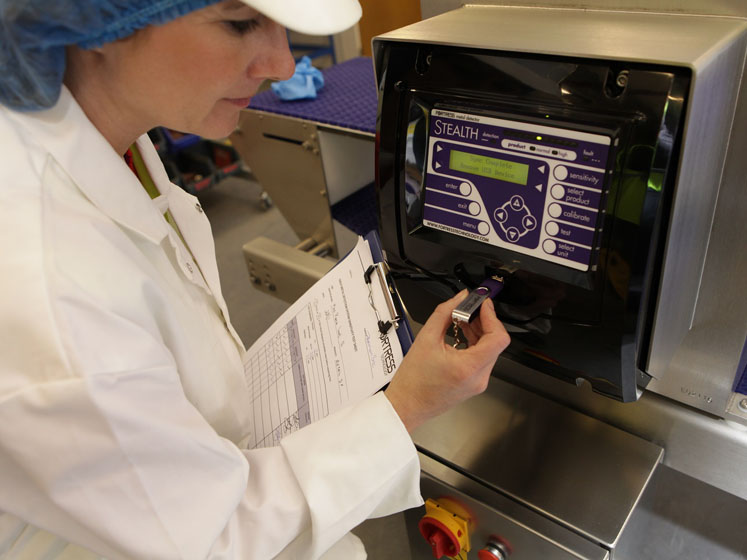Food safety refers to procedures and regulations to prevent the contamination and poisoning of food products. At February’s Global Food Safety Initiative (GFSI) conference, the emerging challenges discussed were diverse.
Topics touched upon supply chain integrity, capability building in developing markets, innovations in technology and data management, allergen management, the changing face of the international retail marketplace and the accelerating growth of third-party certification.
By applying common sense protections from farm to fork and by selecting the most appropriate food inspection technology for the application, Phil believes that transparency can be enhanced and the risk of physical contaminations entering the food chain prevented.
New rules and regulations
Changes to food safety are largely driven by US legislation, with most countries now converging towards the US Food & Drug Administration’s (FDA’s) Food Safety Modernization Act (FSMA) standards. Rather than targeting specific foods or hazards, the FSMA rules focuses on implementing mitigation strategies in registered food facilities. Food imports is a big focus and the FDA is currently working with the European Union to reach a mutually compatible arrangement.
Canada too recently updated its food safety system, implementing the new Safe Foods for Canadians Regulations at the start of 2019. Companies that export to Canada will now need an SFC licence.
Canada’s new rules also place greater emphasis on hygiene and hazardous-based preventative controls. This includes a new standard on recording the chain of custody from the start of production to where they ended up on the shelf.
How data is captured and analysed is critical. Adapting to common standards can help. For example, Contact Reporter is an automated record keeper developed by Fortress to help food processors keep track of and record logs for rejects, tests, settings etc.
Issue 8 of the British Retail Consortium’s Global Food Safety Standard also went live on 1 February 2019. With this latest version, there too is a strong emphasis on hygiene and pathogen contamination, as well as fostering team accountabilities.
The new rules include an additional module now to assess this workplace engagement. The BRC has also updated the rules for deliberate malicious contamination, in addition to food fraud. Greater clarity has been provided for pet food manufacturers.

Phil Brown, European Managing Director of Fortress Technology
In most westernised economies now, food processors document all potential product risks, including naturally occurring hazards. To facilitate this traceability, a Fortress metal detector system offers secure, automatic logging of information to show that the metal detector is operational and working correctly.
This all helps to narrow the time frame during which a problem can go undetected and reducing the amount of suspect products that must be discarded or recalled in case of an incident.
HACCP or HARPC?
The new FSMA law impacts the longstanding Hazard Analysis and Critical Control Point (HACCP) principles, which have been superseded in the US by Hazard Analysis and Risk-Based Preventive Controls (HARPC). However, HARPC is not a global standard. For EU food businesses, the HACCP rules continue to apply.
The biggest difference in the HARPC standards is that they extend beyond Critical Control Points. Now, food processors are mandated to document all potential product risks, including naturally occurring hazards and anything that might intentionally or unintentionally get introduced to their facility. This includes planning for potential terrorist acts, intentional adulteration and food fraud.
Retailer codes of practice
As well as legislative standards, when investing in inspection equipment, food producers and contract packers need to stay mindful of the latest retailer Code of Practice (COP).
The UK has the Groceries Supply Code of Practice. It means that every retailer with a turnover exceeding £1bn must abide by the code and cannot make changes to supplier arrangements retrospectively. While it does mean food suppliers are protected from unfair business practices, if a retailer does make a revision to its Code of Practice (COP) it could put a potentially valuable contract in jeopardy.
The Fortress ‘Never Obsolete Commitment’ helps customers stay compliant with future COP curveballs. A backward-compatibility program, it enables customers to upgrade any existing Fortress metal detector - even those built 20 years ago - helping food processors stay compliant.
To put this into context, an upgrade as a result of a change to a retailer Code of Practice will only set a processor back several hundred rather than thousands of pounds. The cost can be offset through the maintenance budget instead of eating into capital expenditure. What’s more, manufacturers can achieve instant compliance without having to wait for a new machine to be built and installed.
Hygiene compliance
The World Health Organization (WHO) estimates that annually 600 million people worldwide fall ill after eating contaminated food. The globalisation of food production combined with more complex, lengthier food chains places even greater responsibility on food producers and handlers to ensure food safety.
Hygiene features strongly in all of the recently revised global food safety rules.
The processing of ingredients upstream means that many food processors, especially meat and dairy, inspect in liquid form using pipeline systems before inspecting packaged products again using conveyor metal detectors. Upstream, the performance level is often two to three times better. That’s because metal contaminants are caught in their largest form before it is potentially chopped up and dispersed into multiple products.
Given that these liquid lines are often processing high protein foods, pipeline metal detectors need to be able to withstand regular high-pressurised washdowns to prevent bacteria accumulating and stop the spread of foodborne bugs.
Gaining access to pipeline systems for deep cleans has previously been challenging for machine operatives. By upgrading the structure and using plate metal plates, Fortress Technology recently reduced the surface area external to its pipeline metal detector by more than 60%.
Also, by routing the connectors through an encased unit, there are fewer areas where bacteria can hide and thrive during repeated washdowns. Being fitted to a mobile frame means that the system is easier to roll out, giving access to difficult to reach parts that can be easily dismantled and deep cleaned.

Metal risks
Stainless steels are more widely used in food production facilities. In the raw ingredient phase, food is exposed to different processes - from cutting meat, filleting fish, grinding spice or mixing dry and wet baking ingredients. Later down the line, cutting larger quantities into more convenient single serve portions or preparing ready-cut vegetables can again introduce a possible metal contaminant into the food supply chain.
Most containers, pipework and food contact equipment is manufactured from either 304 or 316 type austenitic stainless steels. However, the 300 series is non-magnetic and is also a poor electrical conductor compared to other metal types. These characteristics make stainless steel the most difficult metal type to detect.
In practice this means that in a sphere of stainless steel hidden in a dry product typically needs to be 50% larger than a ferrous sphere to generate similar signal strength. That disparity can rise from 200–300% when inspecting wet product with conductive characteristics.
This was a key rationale for creating the Interceptor range. For items like meat, dairy and ready meals, a Fortress Interceptor unit provides a reliable option for addressing product effect, increasing stainless steel metal detection by 100% and reducing false rejects.
Inspection options
As well as conveyor style systems, metal detectors can be customised to pipeline, gravity, bulk and even low profile products, such as cookies or burgers. Farms also install robust conveyor metal detectors to inspect root vegetables before processing.
Inflation, rising commodity prices, combined with increased labour costs as a result of the National Minimum Wage means that many UK food manufacturers are looking to streamline operations and increase inspection capacity. Consequently, food factories might be more inclined to consider a multi-lane, multi-aperture metal detector as a single unit can inspect different product ranges side-by-side. Additionally, having just one system to maintain can reduce total cost of ownership by over 65% longer term.
Cost remains a major reason why food processors choose metal detectors over x-ray. X-ray continues to be far more expensive, both in terms of capital cost and running costs. Expect to pay in the region of £35,000 to £40,000 to install an entry level X-ray machine, compared to between £4000 and £18,000 for a metal detector. This depends on the size and complexity of the application.
The latest X-ray systems tend not to tolerate difficult or extreme environments quite as well as metal detection. Also, an x-ray machine may have trouble detecting smaller particles and low-density metals – such as aluminium – that metal detectors will easily detect.
Nowadays, metal detectors can inspect products packaged in metallised poly film packaging with a good level of sensitivity. However, pure aluminium foil, for example an oven ready tray, may prove too challenging. In this instance a ferrous in foil detector or x-ray may be recommended.
Traceability
As new food legislation suggests, traceability is, and will continue to be, a key priority. The speed in which a food company can publicly pinpoint the source of a metal contaminant is imperative and can minimise the damage to brand reputation. Again, legislation is driving the adoption of track-and-trace technologies in all food and beverage sectors.
Checking that metal detection systems are failsafe forms part of this agenda. For example, if a fault with the reject system means that a contaminant is detected but not rejected, the line should stop automatically until the situation is resolved. Both the detector performance and fail-safe capability should be tested regularly with results kept on record to support traceability.
As web-based technologies advance, Fortress already has a solution ready to assist companies embrace greater integration.
Automatic testing systems, such as the Halo system from Fortress, are also starting to gain industry acceptance. These systems are designed to complement manual testing with physical test samples to reduce the labour costs associated with owning a metal detector and improve testing effectiveness by eliminating the human error associated with testing. Other benefits of Halo are reduced risk of injury and ensuring proper records are maintained for traceability purposes.
Sharing the food safety responsibility
Being safety minded isn’t just about mitigating risks and ticking the rulebook. Consumers today are more aware than ever about where their food has come from and how it’s being handled right across the supply chain. With today’s social media culture and 24-hour news reporting, a single contamination incident can make national headlines almost instantly. The reputational and financial consequences can be devastating.
“Although technology and automation plays a part, food safety is a shared responsibility. The rules and audits just help to add an additional layer of protection. By working together, food manufacturers, machinery suppliers, production staff, retailers and consumers can raise the bar on food safety,” ends Phil.
